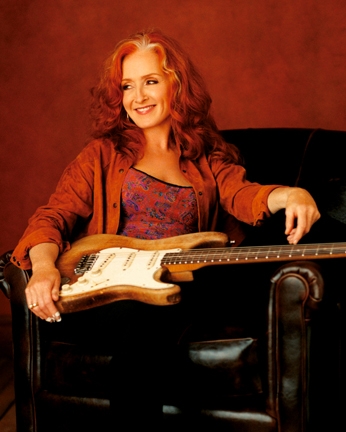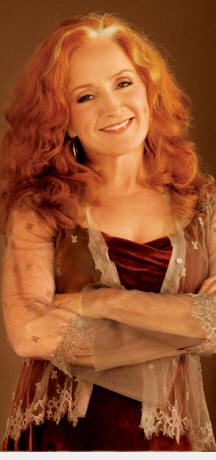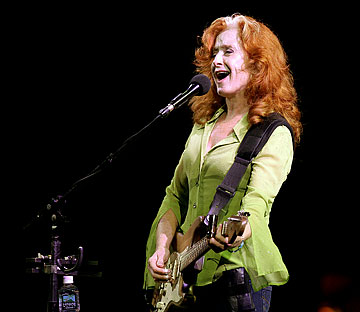 More
than just a best-selling artist, respected guitarist, expressive
singer, and accomplished songwriter, Bonnie Raitt
has become an institution in American music. The release of
Souls Alike, her eighteenth album,
marks yet another brave, exhilarating step in a legendary body
of work.
More
than just a best-selling artist, respected guitarist, expressive
singer, and accomplished songwriter, Bonnie Raitt
has become an institution in American music. The release of
Souls Alike, her eighteenth album,
marks yet another brave, exhilarating step in a legendary body
of work.Born to a musical family, the nine-time Grammy
winner is the daughter of celebrated Broadway singer John Raitt
(Carousel, Oklahoma!, The Pajama Game) and accomplished
pianist/singer Marge Goddard. She was raised in Los Angeles in a
climate of respect for the arts, Quaker traditions, and a
commitment to social activism. A Stella guitar given to her as a
Christmas present launched Bonnie on her
creative journey at the age of eight.
While growing up, though passionate about music from the
start, she never considered that it would play a greater role
than as one of her many growing interests.
In the late '60s, restless in Los Angeles, she moved east to
Cambridge, Massachusetts. As a Harvard/Radcliffe student
majoring in Social Relations and African Studies, she attended
classes and immersed herself in the city's turbulent cultural
and political activities. "I couldn't wait to get back to where
there were folkies and the antiwar and civil rights movements,"
she says. "There were so many great music and political scenes
going on in the late '60s in
 Cambridge."
Also, she adds, with a laugh, "the ratio of guys to girls at
Harvard was four to one, so all of those things were playing in
my mind."
Cambridge."
Also, she adds, with a laugh, "the ratio of guys to girls at
Harvard was four to one, so all of those things were playing in
my mind."
Raitt was already deeply involved with folk
music and the blues at that time. Exposure to the album
Blues at Newport 1963 at age 14 had kindled her interest in
blues and slide guitar, and between classes at Harvard she
explored these and other styles in local coffeehouse gigs. Three
years after entering college, Bonnie left to
commit herself full-time to music, and shortly afterward found
herself opening for surviving giants of the blues. From
Mississippi Fred McDowell, Sippie Wallace, Son House,
Muddy Waters, and John Lee Hooker she learned first-hand lessons
of life as well as invaluable techniques of performance.
"I'm certain that it was an incredible gift for me to not
only be friends with some of the greatest blues people who've
ever lived, but to learn how they played, how they sang, how
they lived their lives, ran their marriages, and talked to their
kids," she says. "I was especially lucky as so many of them are
no longer with us."
Word spread quickly of the young redheaded blues woman, her
soulful, unaffected way of singing, and her uncanny insights into blues guitar. Warner Bros. tracked her
down, signed her up, and in 1971 released her debut album,
Bonnie Raitt. Her interpretations of classic blues by
Robert Johnson and Sippie Wallace made a powerful critical
impression, but the presence of intriguing tunes by contemporary
songwriters, as well as several examples of her own writing,
indicated that this artist would not be restricted to any one
pigeonhole or style.
uncanny insights into blues guitar. Warner Bros. tracked her
down, signed her up, and in 1971 released her debut album,
Bonnie Raitt. Her interpretations of classic blues by
Robert Johnson and Sippie Wallace made a powerful critical
impression, but the presence of intriguing tunes by contemporary
songwriters, as well as several examples of her own writing,
indicated that this artist would not be restricted to any one
pigeonhole or style.
 Over
the next seven years she would record six albums. which featured
her first hit single, a gritty Memphis/R&B arrangement of Del
Shannon's "Runaway." Three Grammy nominations
followed in the 1980s, as she released A compilation of
highlights from these Warner Bros. albums (plus two previously
unreleased live duets) was released as The Bonnie Raitt
Collection in 1990. All of these Warner albums have recently
been digitally remastered and re-released.
Over
the next seven years she would record six albums. which featured
her first hit single, a gritty Memphis/R&B arrangement of Del
Shannon's "Runaway." Three Grammy nominations
followed in the 1980s, as she released A compilation of
highlights from these Warner Bros. albums (plus two previously
unreleased live duets) was released as The Bonnie Raitt
Collection in 1990. All of these Warner albums have recently
been digitally remastered and re-released.
In between sessions, when not burning highways on tour with
her band, she devoted herself to playing benefits and speaking
out in support of an array of worthy causes, campaigning to stop
the war in Central America; participating in the Sun City
anti-apartheid project; performing at the historic 1980 No Nukes
concerts at Madison Square Garden; co-founding MUSE (Musicians
United for Safe Energy); and working for environmental
protection and for the rights of women and Native Americans.
After forging an alliance with Capitol Records in 1989,
Bonnie achieved new levels of popular and
critical acclaim. She won four Grammy Awards in 1990—three for
her Nick of Time album and one for her duet with John Lee Hooker
on his breakthrough album, The Healer. Within
weeks, Nick of Time shot to number one (it is now certified
quintuple platinum). Luck of the Draw (1991, seven-times
platinum) brought even more success, firing two hit singles— "Something
to Talk About" and "I Can't Make You Love Me"
—up the charts, and adding three more Grammys to her shelf. The
double-platinum Longing in Their Hearts, released in 1994,
featured the hit single "Love Sneakin' Up On You"
and was honored with a Grammy for Best Pop Album. It was
followed in 1995 by the live double CD and film Road Tested (now
available on DVD).
After all the awards and honors and decades of virtually
non-stop touring under her belt, Bonnie decided
to take a break and enjoy some of the well-earned rewards of life
off the road. Spending time biking, hiking, and doing yoga,
enjoying family and friends, and traveling for fun instead of
work brought her a great sense of renewal and purpose. Of
course, she never really went too far away, continuing her
activism and guesting on numerous friends' records, including
Ruth Brown, Charles Brown, Keb' Mo, Ladysmith Black Mambazo, and
Bruce Cockburn, as well as tribute records for Richard Thompson,
Lowell George, and Pete Seeger. She picked up another Grammy in
1996 for Best Rock Instrumental Performance for her
collaboration on "SRV Shuffle" from the all-star Tribute to
Stevie Ray Vaughan, and continued her "dual career,"
performing with her father, John, in concerts as well as on his
Grammy-nominated album, Broadway Legend, released in 1995.
take a break and enjoy some of the well-earned rewards of life
off the road. Spending time biking, hiking, and doing yoga,
enjoying family and friends, and traveling for fun instead of
work brought her a great sense of renewal and purpose. Of
course, she never really went too far away, continuing her
activism and guesting on numerous friends' records, including
Ruth Brown, Charles Brown, Keb' Mo, Ladysmith Black Mambazo, and
Bruce Cockburn, as well as tribute records for Richard Thompson,
Lowell George, and Pete Seeger. She picked up another Grammy in
1996 for Best Rock Instrumental Performance for her
collaboration on "SRV Shuffle" from the all-star Tribute to
Stevie Ray Vaughan, and continued her "dual career,"
performing with her father, John, in concerts as well as on his
Grammy-nominated album, Broadway Legend, released in 1995.
In 1998, she returned to the studio with a new collaborative
team to create "Fundamental," one of her most exploratory
projects, signaling her growing desire to "shake things up a
bit." Inspired by the music of Zimbabwean world-beat master
Oliver Mtukudzi, Bonnie wrote "One
Belief Away," the first single, with Paul Brady and
Dillon O'Brian.
In March of 2000, Bonnie was inducted into
the Rock & Roll Hall of Fame; this was followed by her welcome
into the Hollywood Bowl Hall of Fame, along with her father, in
June 2001. Over the years, Bonnie has appeared
as a guest on over 100 album projects, as chronicled in the
discography section of her official website. She continues to
stretch the boundaries, performing with artists as varied as
Cape Verdean singer Cesaria Evora, and legends B.B. King, Tony
Bennett, & Willie Nelson.